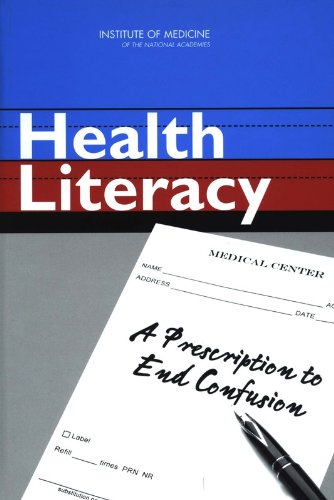Health Literacy: A Prescription to End Confusion - Hardcover

To maintain their own health and the health of their families and communities, consumers rely heavily on the health information that is available to them. This information is at the core of the partnerships that patients and their families forge with today‚€™s complex modern health systems. This information may be provided in a variety of forms ‚€" ranging from a discussion between a patient and a health care provider to a health promotion advertisement, a consent form, or one of many other forms of health communication common in our society. Yet millions of Americans cannot understand or act upon this information. To address this problem, the field of health literacy brings together research and practice from diverse fields including education, health services, and social and cultural sciences, and the many organizations whose actions can improve or impede health literacy.
Health Literacy: Prescription to End Confusion examines the body of knowledge that applies to the field of health literacy, and recommends actions to promote a health literate society. By examining the extent of limited health literacy and the ways to improve it, we can improve the health of individuals and populations.
Table of Contents- Front Matter
- Executive Summary
- 1 Introduction
- 2 What Is Health Literacy?
- 3 Extent and Associations of Limited Health Literacy
- 4 Culture and Society
- 5 Educational Systems
- 6 Health Systems
- 7 Vision for a Health Literate America
- Appendix A: Data Sources and Methods
- Appendix B: Commissioned Papers
- Appendix C: Sample Material from Selected Assessments of Literacy and Health Literacy
- Appendix D: Committee and Staff Biographies
- Index
"synopsis" may belong to another edition of this title.
Copyright © 2005 Massachusetts Medical Society. All rights reserved. The New England Journal of Medicine is a registered trademark of the MMS.
"About this title" may belong to another edition of this title.
- PublisherNational Academies Press
- Publication date2004
- ISBN 10 0309091179
- ISBN 13 9780309091176
- BindingHardcover
- Edition number1
- Number of pages366
- EditorKindig David A., Panzer Allison M., Nielsen-Bohlman Lynn
- Rating
Buy New
Learn more about this copy
Shipping:
FREE
Within U.S.A.
Top Search Results from the AbeBooks Marketplace
Health Literacy: A Prescription to End Confusion
Book Description Hardcover. Condition: New. Brand New!. Seller Inventory # VIB0309091179
Health Literacy: A Prescription to End Confusion
Book Description Hardcover. Condition: New. Seller Inventory # Abebooks42232
HEALTH LITERACY: A PRESCRIPTION
Book Description Condition: New. New. In shrink wrap. Looks like an interesting title! 1.45. Seller Inventory # Q-0309091179
Health Literacy: A Prescription to End Confusion Nielsen-Bohlman, Lynn; Panzer, Alison M. and Kindig, David A.
Book Description Condition: New. Seller Inventory # XAE3--0095
Health Literacy: A Prescription to End Confusion
Book Description Hardcover. Condition: Brand New. 1st edition. 368 pages. 9.00x6.00x0.75 inches. In Stock. Seller Inventory # 0309091179

